Greggs(LON:GRG)’ substantial progress with the brand transformation, backed by savvy use of social media, helped to deliver robust FY18 results, in spite of weather extremes, and an outstanding start to FY19. Consequently we have upgraded our forecasts three times since late November. The company is highly cash generative and likely to distribute part of the substantial cash balance (FY19e: £92.9m) with the H119 dividend.
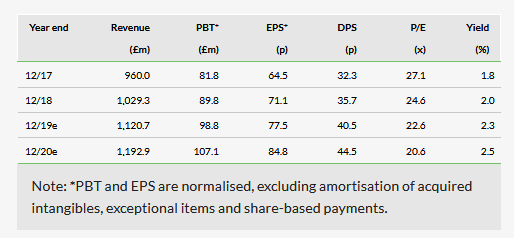
Brand transformation delivering robust results
Greggs is smartly engaging social media to raise the profile of its brand, which has successfully transitioned into a leading food-on-the-go format, and draw new customers into the shops. In spite of weather extremes, the broad and innovative freshly-prepared ranges helped to deliver FY18 like-for-like (l-f-l) and total sales growth of 2.9% (H1: 1.5%, H2: 4.2%) and 7.2%, respectively, and a 9.8% increase in underlying PBT. In the first seven weeks of FY19, widespread publicity of the now-famous vegan sausage roll contributed to outstanding l-f-l sales growth of 9.6%.
Momentum with new strategic initiatives
Greggs has made significant inroads into strategic plans set out in 2013, and the vision for brand repositioning continues to evolve at pace. Trials of online ordering for collection and delivery are underway in select locations, with demand for the latter typically highest in the evenings when shops have traditionally been closed. 37% of shops are now in travel and workplace locations, with a mid-term objective of 60%.
Three recent earnings upgrades
After a third unscheduled upgrade (of 8%) in February we leave FY19 operational assumptions unchanged. Against a weak, weather-affected H1 comparative we factor in 6% l-f-l growth, reducing to a potentially overcautious 1% in H2. Our FY20 forecast assumes 2% l-f-l sales growth and slight margin improvement. Both our FY19 and FY20 forecasts have reduced by c 4%, purely to reflect the non-cash impact of IFRS 16, which the company, along with peers, will adopt this year.
Valuation: Cautious assumptions; cash distribution
Greggs’ shares trade c 8% below our DCF valuation of 1,897p, which assumes revenue growth beyond FY21e of 6% cautiously faded to 2% and a perpetuity EBITDA margin of 15.7% (2021e:14.8%). Our EV/EBITDA peer comparison implies 1,804p. The company is highly cash generative and is expected to distribute surplus cash in excess of £40m (FY19e: £92.9m) with the H119 dividend.
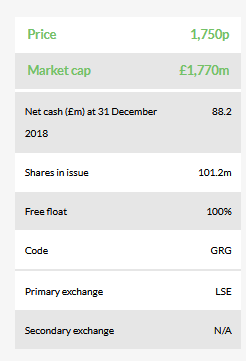

Business description
With 1,953 shops, eight manufacturing and distribution centres and 23,000 employees, Greggs is the UK’s leading ‘food-on-the-go’ retailer. It uses vertical integration to offer differentiated products at competitive prices.
Investment summary
Company description: Dynamic strategy for fast-moving market
Greggs has a strategic objective of becoming the customers’ favourite for food-on-the-go (FOTG). The strategy has four pillars: (1) great-tasting freshly prepared food; (2) the best customer experience; (3) competitive supply chain; and (4) first-class support teams. It has evolved its product range to appeal to new classes of customers, while retaining traditional baked products. Non-traditional ranges now comprise more than 30% of sales (2013: 15%). 37% of stores are now in travel and workplace locations, up from 20% in 2012, and with an objective of 60%. Since 2016, Greggs has been engaged in a £100m investment programme in its manufacturing and distribution infrastructure, which will create capacity to serve more than 2,500 outlets from national centres of excellence. Greggs has not advertised its brand transformation above the line but is using social media to exploit the public’s fondness for the brand while disrupting entrenched attitudes.
Financials: Robust trading performance; a special dividend
After a slow start affected by extreme weather, l-f-l sales advanced progressively to 5.2% in Q4 of FY18. This contributed to overall l-f-l and total sales growth over the full year of 2.9% and 7.2%, respectively. Gross margins have been held, consistent with ingredient cost pressure in the year mitigated by cost reductions, mainly emanating from the supply chain actions. Net cash is a substantial £88.2m, having increased by £33.7m in the year.
FY19 has started strongly, with the vegan sausage roll driving 9.6% l-f-l growth for the first seven weeks. Having upgraded our forecasts three times since November (most recently an 8% FY19e earnings upgrade in mid-February), we make no further changes to our assumptions for l-f-l growth and margins. Our FY19 and FY20 PBT forecasts have reduced by 3.9% and 4.4%, respectively, purely to reflect the non-cash impact of IFRS 16: Leases, which the company will adopt, as with peers, this year. Management has reiterated its policy to distribute surplus cash (over c £40m) and, barring unforeseen circumstances, expects to announce a special dividend with the interim results. On the basis of our FY19e £92.9m cash forecast this would imply c 53p per share.
Sensitivities: Consumer economy and retail landscape
We see the main sensitivities as:
Challenges within the consumer economy.
Brexit, specifically: (1) disruption of fresh ingredients supply; (2) potential tariffs; (3) the value of sterling; and (4) further impacts on consumer demand.
Input costs, including currency and regulatory cost pressures.
Marginalisation of terrestrial retail locations faster than management can act to relocate.
Execution risk from the supply chain programme, and concentration of supply sites.
Changes to immigration policy causing labour shortages and cost increases.
Valuation: Share price in line with DCF and peer group
Greggs’ shares have appreciated more than 40% since last November and now trade c 8% below our DCF valuation of 1,897p. This is based on a cautious forecast with revenue growth fading beyond FY21 to a perpetuity rate of 2%. The share price is slightly below the market’s valuation of its peer group on an EV/EBITDA basis, although a substantial premium to the same group’s average P/E ratio. The latter, we believe, is distorted by two heavily indebted companies in the peer group, in contrast to Greggs’ substantial net cash position.
Company description: Always on the go
Greggs has a strategic objective of becoming customers' favourite for food-on-the-go. The company was founded by John Gregg as a Tyneside bakery in 1939 and grew to become a national chain. From 2013 it adopted a strategy of transforming itself into a value food-on-the-go retailer.
There are four pillars to its strategy:
1. Great-tasting freshly prepared food: Greggs seeks to differentiate itself by highlighting high-quality and freshly prepared food, which is also competitively priced in the value market.
2. Best customer experience: the key elements are service and convenience. Convenience is strongly defined by location as well as format, areas of strong focus. Service needs to be simple and straightforward, and the company focuses on its in-store processes.
3. Competitive supply chain: hand-in-hand with the developing estate, Greggs is working to rationalise what used to be a regional bakery estate into centres for national production of its major product lines.
4. First class support teams: the support function is largely governed by systems, where the company is implementing SAP throughout the organisation.
We now consider where it stands and where it is going in terms of each pillar of its strategy.
Fresh food offer: Meeting wider consumer needs
Greggs has purposefully evolved its range of products in order to appeal to new classes of customers, while also retaining traditional baked products.
Non-traditional ranges such as hot drinks, breakfast, healthier choices and hot food are growing strongly and now account for more than 30% of sales against 15% in 2013.
Hot drinks: Greggs’ upgraded coffee offer, as well as other hot drinks, targets the coffee chains. Significant investment in coffee machines has driven speed of service and choice extension. Coffee, as well as being a high-margin product in its own right, can attract new customers into stores.
Breakfast: Greggs has a competitive place in the working breakfast market with its value deal. It has progressively rolled out the options and now for example offers croissants, porridge, fresh fruit and yoghurt, as well as sausage and bacon rolls. The basic offer of a sausage or egg roll and a hot drink at £2 is competitive against McDonald’s (NYSE:MCD) and Costa, for example. The development of the breakfast range is a significant step in the move towards relative balance between dayparts.
Dietary choices: Greggs is a leader in reduced sugars, salt and fats with its FOTG products and has recently added vegan-friendly and gluten-free options. The company formalised its Balanced Choice sub brand in mid-2014, representing meals containing less than 400 calories. Currently, the standard store fit-out includes significant display area devoted to Balanced Choice, and the range is seeing high single-digit growth (healthy options as a whole are growing in double digits). In January 2019 Greggs caused a social media sensation with the launch of its vegan sausage roll product.
Hot food: while Greggs has always had heating equipment for its baked products such as sausage rolls, bacon and sausages, range extension opens up new options such as hot sandwiches, soups and burritos. While the move into hot food brings its own workflow challenges, they also represent a major opportunity for extension into the evening, creating the potential for transformation in utilisation of the store asset.
The experience: Convenience, location and format
Store repurposing
Greggs has made decisive progress in moving its offer from that of a high street baker to the current food-on-the-go brand. The store refurbishment objective has been emphatically achieved, with substantially all its sites now refurbished on a food-on-the-go format.

The emphasis within estate development is now shifting to locate the brand in its most appropriate market. This is not necessarily on high streets, and 37% of the estate, or some 720 stores, is now located in catchments other than traditional shopping locations, up from 20% in 2012. These include transport hubs, bus stations, train stations, petrol stations, office developments and drive-thrus. In March 2018 Greggs opened its first shop on the London Tube, at Westminster, and there is scope for this to be followed by others. The medium-term objective is for 60% (previously 50%) of the estate to be in non-retail locations.
Greggs is expanding its geography to new territories such as the county of Devon, and is adding to its footprint in Northern Ireland (currently 16 shops). The business model is evolving, with 262 shops now trading in franchise formats, an increase of 62 in the year. Franchise shops, operated by partners in travel and convenience locations, offer some protection from the ongoing reduction of high street footfall.
Looking forward, management sees potential in digital order pads of the kind adopted by McDonald’s, although these would be subject to appropriate system changes. In addition, trials of online ordering for collection or delivery are underway, the latter in partnership with Uber Eats and Deliveroo, which could result in further revenue opportunities.
Supply chain: Modernisation, rationalisation
Since 2016, Greggs has been carrying out a £100m investment programme to upgrade its national manufacturing and distribution infrastructure. The objective, once completed in 2021, is to create capacity to serve more than 2,500 outlets from national centres of excellence in specified products. These will capture economies of scale while ensuring consistent product quality across the brand.
In 2016 a new distribution centre was opened in Enfield, while bakeries at Twickenham and Sleaford, which were unsuitable for upgrade, were closed. In 2017 the company completed the transfer of its Edinburgh operations to its Glasgow bakery, which has been extended to become a centre of excellence for Yum Yum production. The Leeds bakery was extended to create a centre of excellence for cake and muffin manufacturing. 2018 was the peak year for investment, including the creation of centres of excellence for doughnuts at the Gosforth Park bakery, pizza production in Manchester and fresh cream products in Leeds. A further bakery and distribution facility in Norwich was closed.
In the current year, the programme to consolidate manufacturing into centres of excellence will be completed and a new distribution centre will be opened in Amesbury, Wiltshire, to support growth plans in the south-west.
The following table sets out management’s financial assessment of the programme, phased over the five-year period. Although it includes significant capex, it also avoids spend that would have been invested in the previous establishment. On that basis, and including disposal proceeds, the project as a whole produces an annualised net return on investment, after five years, of 23%.
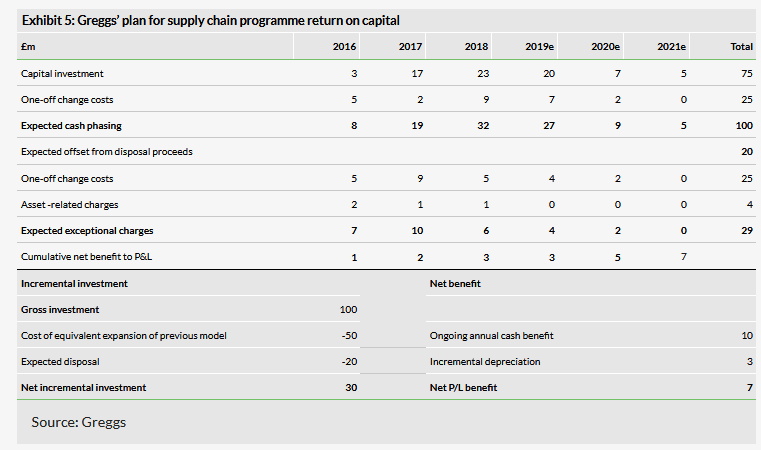
First-class support teams
Greggs’ vision of FOTG depends crucially on prompt and efficient service. This is particularly important in Greggs’ small physical format. While management is working to even out differential demand between dayparts, queues at busy times such as lunchtime remain common and there is an obvious risk of losing customers as well as causing dissatisfaction. Conversely, an improved rate of service can directly contribute to revenue.
Greggs invests in technology and processes to free staff time to devote to customer service, as well as to reduce absolute cost. The supply chain investments covered above should support progressive improvement in stock availability. Following the deployment of SAP Finance in FY16, the company successfully rolled out its central forecasting and replenishment process in FY17, replacing traditional, shop-based, manual ordering processes. This brings benefits in terms of improved product availability, and management expects lower wastage as staff become more experienced with the system’s capabilities. In addition, the system is bringing staff efficiency and better customer service by freeing store staff from a regular clerical exercise. In 2018 the SAP modules for human resources and property management were implemented, with payroll now underway, leaving the integration of logistics and manufacturing sites to complete by 2021.
Changing consumer perceptions of the brand
Greggs is a national brand: its footprint of 1,953 stores compares well with competitors such as Marks & Spencer (c 1,000), Morrisons (c 500) and MacDonald’s (c 1,200). The comparison is not exact, but Greggs’ management considers its competitive set to be supermarkets, convenience stores, delivery outlets and coffee shops (in that order).
While customers’ acceptance of Greggs’ wider and more contemporary offer is reflected in its consistently improving like-for-like sales, we think wider awareness of the change in the brand among non-customers is likely to be a relatively slow burn.
Greggs does invest in marketing on social media (see below). It has 730,000 followers on Facebook (NASDAQ:FB) (vs 685,000 a year ago), 166,000 on Twitter (vs 139,000 a year ago) and 31,000 on Instagram (vs 15,000 a year ago). Its social media sites are managed to generate a flow of ‘fun’ content. They typically publicise product offers, promotions and events. One example is the ‘vegan sausage roll finder’, which allows you to enter your postcode to find the nearest shop selling the item. They also serve as a channel for customer reaction both negative and positive to the company’s products and service, giving a valuable opportunity for dialogue with the customer.
Unlike competitors such as McDonald’s, Tesco (LON:TSCO) and Domino’s Pizza, Greggs does not invest in above-the-line advertising. Management takes the view that direct sight, word of mouth and social media channels are a more cost-effective and efficient method.
It is beyond the scope of this note to gauge the effect of direct advertising on a brand repositioning exercise, but logic dictates that there is one, and Burberry, McDonald’s and Tesco are among major companies that thought it advisable to communicate brand repositioning using the media. We make three deductions:
1. Greggs’ widespread shop presence, communicating the food-on-the-go image, is undoubtedly helpful in showing non-customers as well as customers what the brand represents.
2. The move to new locations is likely to attract the attention of further new customers.
3. However, without above-the-line advertising, the message may take longer to percolate into the national consciousness.
This is good and bad for the company’s prospects. The benefit of changed market perceptions may take longer to be reflected in the top line. However, the significant costs of above-the-line advertising are avoided.
Management analyses that its shop investments currently pay back in two years for a relocated shop and three years for a new shop (both take an additional year when the supply chain is taken into account). In addition, improving brand perception should pull in new customers over time, enhancing like-for-likes and lengthening investment returns.
Digital strategy
Greggs’ management is developing the best ways of moving forward on its digital strategy. Key elements are the popularity of the brand on social media, the Greggs Rewards card and app, online ordering and the increasing demand for delivery as well as click-and-collect.
Greggs’ social media presence: case study – the vegan sausage roll
Greggs works closely with its PR partners to exploit the public’s fondness for the brand in order to prompt reappraisal. An example, hailed as a “masterclass” by PR press, is the January 2019 Vegan Sausage Roll campaign, by external agencies and the Greggs marketing team. The immediate prompt for the launch was a 2018 PETA (People for the Ethical Treatment of Animals) petition by 20,000 people asking for a vegan sausage roll. However, Greggs had been developing the product for two years, and had already seen success with its Mexican Bean Wrap, launched in 2018.
The social media concept was an Apple (NASDAQ:AAPL) iPhone-style launch, complete with a short ‘spoof tribute’ video in the style of an Apple advert.
The reaction was huge, with over 400 pieces of media coverage landing in 48 hours and Greggs trending #3 on Twitter. The launch sparked mass debate among the public, with celebrities like Piers Morgan and Ricky Gervais joining in the conversation.
Greggs’ research since launch suggests that one in eight buyers of the product is a new customer. However, the product has also increased frequency of use by existing customers, particularly on savoury products. Management believes that the effect of the product has been to reassure customers that they can visit more often without compromising the quality of their diet. While the launch has continued to boost sales in the first two months of 2019, there is clearly room for a follow-up (probably several) although management is understandably not pre-announcing details.
Greggs Rewards scheme
In 2016 the company relaunched Greggs Rewards, its digital loyalty scheme. Greggs Rewards includes an app that customers can scan in the shop to get free coffee and other products. The app extends payment options through a reloadable account. Greggs Rewards has now been upgraded to include satisfaction ratings, providing better information on customers. However, it is currently used by under 10% of customers. Management plans to invest further in the scheme to broaden its user base and improve the quality of customer information it provides.
Online ordering, delivery and click-and-collect
As noted on page 5 above, a trial partnership for online ordering for delivery with Uber Eats and Deliveroo is being tested under the name ‘Greggs Delivered’, and is active in Newcastle and Manchester. The same formula is naturally suitable for click-and-collect. Management is aware of potential conflict between in-store and online customers and is seeking ways to manage them in its current store trials.
The potential for Greggs to function as a delivery originator is a factor that the company is taking into account as it approaches the next cycle of store refurbishments. A particular opportunity that management is considering is the fact that delivery demand is highest at times of day when the stores are traditionally closed, so that there is a potential opportunity to generate further value.
Greggs’ market: On-the-go value food
We consider Greggs in the context of the eating out market and also as a value food retailer.
The UK eating out market: Restaurants being taken out
Eating out in the UK is a £96bn market, which has grown strongly in recent years, although it flattened in 2018:

As well as the effect of declining consumer confidence, a once well-defined restaurant market has fragmented under the influence of lifestyle changes, time shortage and cost pressures. The dine-in model is increasingly differentiated from takeaway and delivery, which are increasingly merging.
Traditional restaurant model under threat
Traditional sit-down dining models are being threatened by over-supply and challenged demand, while margins have been affected by higher food, labour and rent costs. A report by Moore Stephens states that in the tax year 2017/18 UK restaurant insolvencies at 1,219 were up 24% year-on-year and nearly double the rate of 2010/11. Restaurant Group, which first signalled trading problems in January 2016, recorded like-for-like sales down 3.9% for that year and 3.0% for 2017. In a review, the company identified the loss of value-conscious customers as the primary cause, resulting from price increases and the removal of popular value offers. However, in 2018, like-for-like sales decline had only reduced to 2%. In July 2018, Gaucho Group went into administration, while other brands have announced significant closure programmes, for example Prezzo (94), Carluccio’s (up to 34), Byron (20), Gourmet Burger Kitchen (17), Jamie’s (12) and Strada (11).
Dynamic takeaway and delivery model
By contrast, the UK has seen a 34% increase in fast food outlets from 2010 to 2018 (source BBC, ONS). Domino’s Pizza increased UK like-for-like sales by 4.5% in 2018. Just Eat’s app-based delivery operation recorded 27% UK revenue growth in 2018. However, we believe that Just Eat and its more premium competitors, Deliveroo and Uber Eats, which predominantly deliver to the home, are not generally direct competitors to Greggs, whose customers are already out and about.
Supermarkets hold their own
Supermarkets (subject to location) and convenience stores are closer competitors to Greggs as they may offer convenience and value to customers on the move. The MCA UK Eating Out market report 2018 showed that they have grown their share of this market by 0.2 percentage points between 2015 and 2018. With growth of 0.7%, they now hold a 13.5% share of all out-of-home eating occasions.
Greggs’ terrestrial presence
While Greggs retains some seating, following refurbishments since 2013, its offer is predominantly food-on-the-go, as the company’s strapline indicates. In this way it is different from either dine-in or delivery models. To the extent it is represented on high streets it is exposed to declines in terrestrial shopping footfall. However, the company is taking action to address this, with increasing presence in workplace, travel and leisure locations. Management puts its exposure away from shopping locations at 37% of the portfolio, with an objective to grow that to over 60% in the longer term.
Value retailers market
Another relevant dimension in which to view Greggs’ market presence is that of value food retail, its London Stock Exchange sector. With CPI inflation forecast at c 2.3% in 2019, real household income growth at 1% (source: BoE), and personal borrowing set to correct from a 50-year low in the household savings ratio, consumers remain under pressure. While staple food and drink is to some extent insulated from pressures affecting discretionary purchases, even here the consumer faces challenges. Value supermarkets are increasing the pace of share gains: in the two years to December 2018, Aldi and Lidl grew theirs by 2.4% to 12.8%, while the majors all declined, according to Kantar’s online indicator.
Management: On a mission
The team under Roger Whiteside has engaged with the change task with a sense of conviction and urgency. Whiteside is a career retailer originally from Marks & Spencer, where he acquired experience of operating multi-site food retail. He was on the founding team at Ocado (LON:OCDO), and CEO of Threshers before joining Punch Taverns. On becoming CEO of Greggs in 2013, he set out his vision for the brand’s transformation, which has since become his mission.
Financials: Strong profit and cash prospects
2018 results: Increasing strength through the year
Total sales were up 7.2% to £1,029.3m, driven by managed like-for-like sales up 2.9%. Pre-exceptional PBT was up 9.8% at £89.8m. Pre-exceptional diluted EPS were up 10.7% at 70.3p, and the total dividend was raised 10.5% to 35.7p. Underlying cash performance was very strong despite some timing issues contributing to December 2018 net cash of £88.2m, up £33.7m on the year, and management expects to declare a special dividend with interim results (it views c £40m as an appropriate level of cash to retain in the business).
After a slow first quarter affected by extreme weather, results improved smartly in the second half, with sharply higher revenue growth and operating margin, which reversed its year-on-year shortfall in H2. At pre-tax level, the H2 contribution rose from 66% to 71% of full year profits.
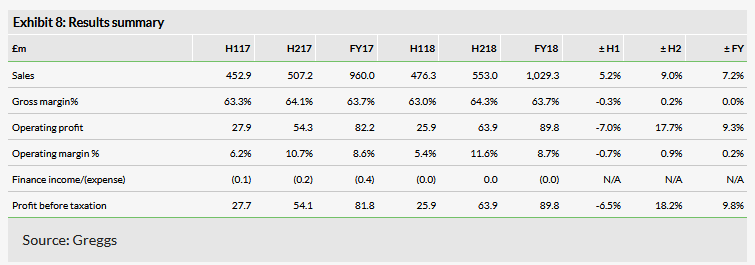
Revenue has showed a robust and consistent trading pattern, though depressed by extreme weather in Q118, but with sustained like-for-like sales increases averaging around 3.3% over the two years to the end of 2018, and increasing dramatically in early 2019 to 9.6%:

Gross margin has been held at 63.7%, consistent with ingredient cost pressure in the year mitigated by cost reductions, mainly emanating from the supply chain actions. A small increase in distribution and selling costs was effectively countered by central administrative efficiencies:
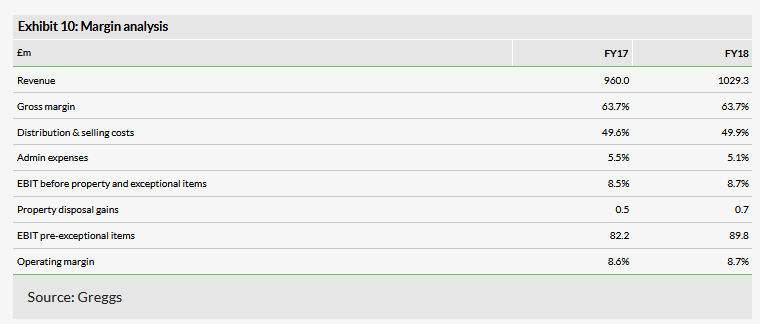
February 2019 trading statement: Material early strength
Trading in the first seven weeks was exceptionally strong, with l-f-l sales growth of 9.6% (FY18: 2.9%) and total sales up 14.1% (FY18: 6.2%). Demand was led by the newly launched vegan sausage roll, but extended to other savoury products. Early supply problems given the scale of demand for the vegan sausage roll have been resolved, with more than 80% of stores now being supplied. The exceptional growth to date also benefited from last year’s extreme weather, and has pulled back slightly in February. However, it should still leave the first half materially ahead of expectations, against weak H118 comps. On our assumption of 6% H119 l-f-l growth, we upgraded our FY19 PBT and EPS forecast by 8% in February. We continued to assume H2 l-f-l growth of only 1% as comps strengthen, leaving potential for further upside if this proves to be over-conservative.
Outlook and forecasts
Management has confirmed that, beyond the seven-week update provided in February, the week eight l-f-l remained at a similar level while an exceptional l-f-l performance seen in week nine was heavily distorted by the impact of snow in the same week of the prior year. It expects to continue benefiting from strong momentum in the first half, before comps toughen.